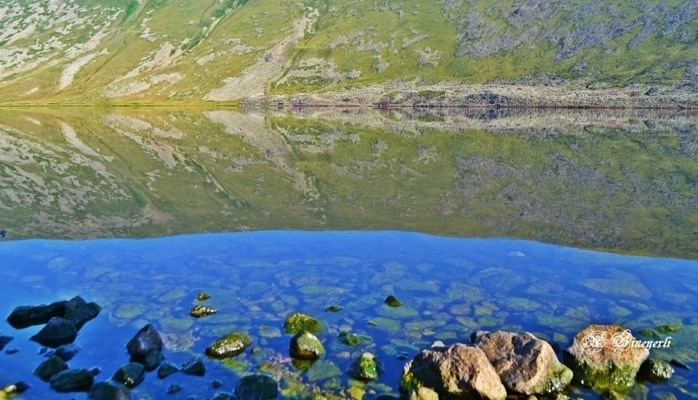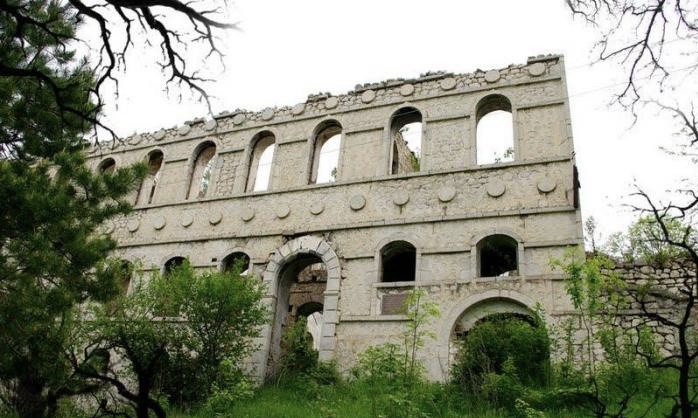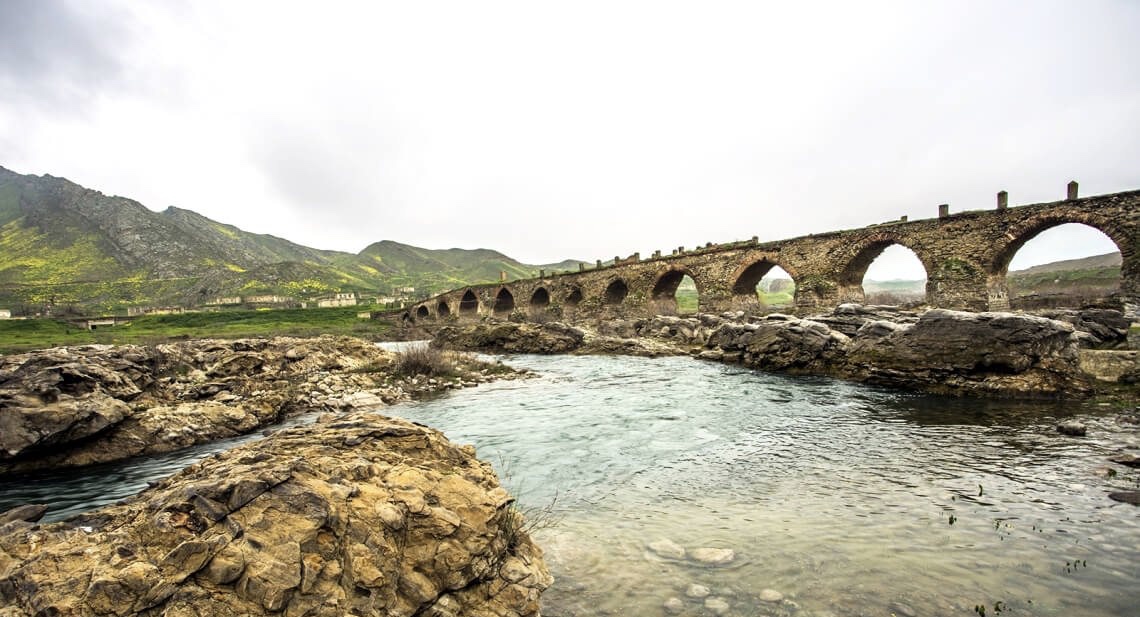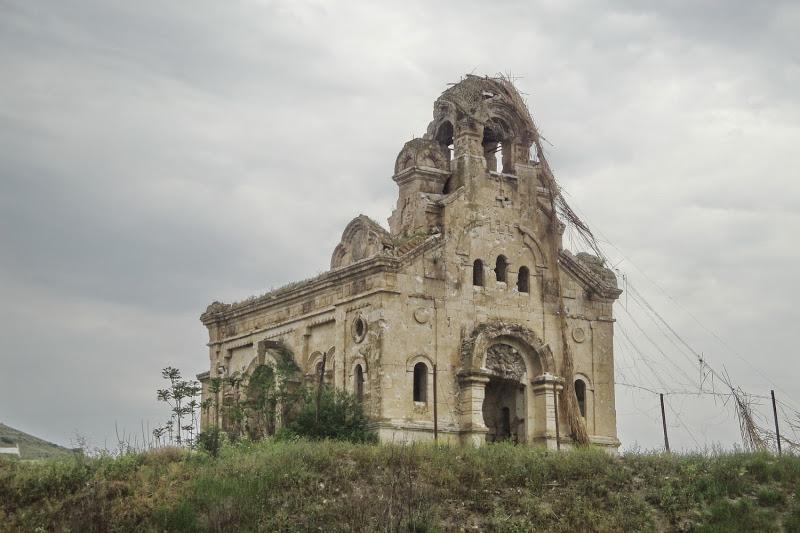






of







of







of





















In 1960, Mammadali Huseynov, a prominent Azerbaijani archeologist, discovered Azikh cave, an ancient human settlement on the banks of the Guruchay River. Azikh cave was considered to be an outstanding scientific discovery in archeological history, due to its rich findings. Between 1960 and 1980, a major archeological study of the cave was conducted by Azerbaijani scientists and archeologists, to investigate the cultural layers in an area of less than 8,000 square meters. The archaeologists restored a corridor in the cave divided by eight large grottoes with 20-meter-high domes and 2-meter-long stalactites with a girth of 1.5 meters. The cave is one thousand meters high.[1]
In 1968, Huseynov found a piece of jaw with two teeth in the cave’s fifth stratum, which was considered to be a scientific discovery that was essential to Azerbaijan’s archeological historiography. The investigation that was carried out with the help of modern methodologies and technical tools proved that this piece of jaw belonged to a woman between the ages of 18 and 22[2] who lived 350,000-400,000 years ago (the Middle Ashel Age in the Lower Paleolithic Period).[3]
This was the most ancient jaw discovered in the territory of the former Soviet Union and was given the name called “Azikhantrop” (“human from Azikh”).[4] According to Lumlee, the French paleontologist, the “Azikhantrop” is the fourth oldest human relic ever found in the world. The first one had been discovered in the Olduvai Gorge, Tanzania, by Richard Leakey, the second one in Kenya, and the third one in France. The “Azikhantrop” is the oldest discovery ever identified in the entire former Soviet Union.[5]
Azikh cave is particularly important because every stage of Stone Age history is represented there. Azikh cave has ten cultural layers and stratums with a total capacity of 10-14 meters. In the seventh and tenth stratums of the cave historical artifacts are belonging to the early Stone Age. Furthermore, in the cave’s third, fifth, and ninth stratums, more than 15,000 Lower Paleolithic stone tools and artifacts used by ancient humans have been found. The fifth and tenth layers are considered the oldest layers, and they belong to the pre-Acheulean Period.[6]
Archeologists maintain that the discoveries in the cave’s fourth stratum refer to the history of making fire. Thus, with the impact of hunting, people who lived at that time dug pits in the ground for making artificial hearths. They surrounded these hearths with masonry or semicircular bars. It seems that the place the fire was made was used not only for cooking but also for preserving the fire. In the early 1970s, five similar hearths were found in different stratums of the cave. “One was surrounded by a crescent-like stonewall foundation 30 centimeters thick… It is the first known construction in the history of humankind and the first known fireplace. It most probably dates back to the period 700,000-500,000 years ago”.[7]
Scholars maintain that “Azikhantrop” was also dealing with the construction to create artificial living places. “A bear’s skull found in the Azikh cave has eight slanting lines inscribed on it and gives us some further insight into the mysterious spiritual life of the “Azikhantrop”. These lines could be a reflection of any thought, number, ritual, picture, etc. The fact that such attention was paid to a bear’s skull, and not to other animals, is indicative of early totemism”.[8]
The discovery of Azikh cave caught the attention of a large scientific audience around the world. Scholars identified it as a significant step toward gaining a better understanding of the most ancient history of the human being. The cave’s discoveries were thus exhibited at the Paris International Exhibition – the most ancient inhabitants of Europe – on December 8, 1981.[9] Furthermore, because of this finding, Azerbaijan was included on the map of “the most ancient inhabitants of Europe” and Azikh cave was recognized as one of the oldest human settlements in the world. In 1984 an extensive article regarding the findings of the Azikh cave was published in a Czechoslovak anthropological journal. Furthermore, the book titled “First Human” which was about the jaw of the primitive man found in the Azikh cave was published by the world-famous French scientist Henry de Lumley in 1998.[10]
However, after the occupation of Nagorno-Karabakh and seven surrounding regions, Armenians began to destroy historical artifacts in those regions and to falsify the history of Azerbaijan. In his book “History and Architectural Monuments of Nagorno-Karabakh”, S. Mkrtchyan writes that “a woman’s “statue” belonging to the Acheulean culture had been found in the Azikh cave and that the woman’s clothing was very similar to the clothing of modern Armenian women”.[11] Another Armenian scholar, S. Khanzadyan, a literary critic with little knowledge of archaeology, supported Mkrtchyan’s groundless idea in his review of Mkrtchyan’s book that was published in the “Avanqard” journal in 1986. However, in reality, it was a 2-meter stone stalactite that was topped by ice as a result of water dropping for thousand years.[12]
[1] Султанов, Р.Г., “Геологическое строение палеолитовых карстовых пещер Азыха и Таглара в Нагорном Карабахе Азербайджана”, Материальная культура Азербайджана (Баку, 1974), Том VII, p. 32.
[2] Cəfərov, Ə., Quruçay dərəsində (Bakı, 1990), pp. 31-34.
[3] Алиев, И.Г., Нагорный Карабах: история, факты, события (Баку, 1989), p. 7.
[4] Zardabli, Ismail bey, The History of Azerbaijan: From Ancient Times to the Present Day (Rossendale Books, 2014), p. 14.
[5] Mustafayev, Arif, “Jawbones and Dragon Legends: Azerbaijan’s Prehistoric Azikh Cave”, Azerbaijan International, Vol. 4, No. 2, 1996; http://www.azer.com/aiweb/categories/magazine/42_folder/42_articles/42_azikhcave.html. Accessed on October 1, 2020.
[6] Султанов, Р. Д., “Геологическое строение Азыхской пещеры в долине р. Куручай”, Материалы сессии, посвященной итогам археологических и этнографических исследований 1964 г. в СССР. Тезисы докладов (Баку, 1965). See also: Ширинов, Н.Ш., “О геоморфологической датировке возраста Азыхской пещерной стоянки палеолитического человека”, Материалы сессии, посвященной итогам археологических и этнографических исследований 1964 г. в СССР (Баку, 1965). See also: Гусейнов М.M., Древний палеолит Азербайджа- на (Баку, 2010), pp. 12-62.
[7] Mustafayev, “Jawbones and Dragon Legends”.
[8] Shukurov, Karim K., “A History of Azerbaijan: From the Furthest Past to the Present Day”, Vision of Azerbaijan, March-April, 2010; http://www.visions.az/en/news/35/fdf8b4b9/. Accessed on October 1, 2020.
[9] Cəfərov, Quruçay dərəsində, p. 36.
[10] Jafarov, Asadulla, “Archaeological monuments of Karabakh and attempts to “Armenify” them”, Irs Karabakh, Vol. 4, No, 32, 2017, p. 47.
[11] “Armenian excavations in Azikh or how history is falsified”, Heritage, Vol. 4, No. 23, 2015, p. 12. See also: Karabağ Sorular ve Gerçekler (İstanbul, 2011), p. 16.
[12] Karabağ Sorular ve Gerçekler, p. 39.

Qaragol Interrepublics State Reserve was set up with the decision of the Council of Ministers dated November17, 1987. Garagol State …

The idea of establishing Aghdam Bread Museum, which is considered to be the second in the world after the Zurich …

The Khurshudbanu Natavan’s House is a historical and architectural monument of the 18th century located in the city of Shusha. …

Museum Mausoleum Complex of Molla Panah Vagif is located in Shusha, Azerbaijan. It was built in honor of Molla Panah …

The Bridge belongs to the Arran architecture school. The first written source that mentioned the 15-arched Khudafarin Bridge belongs to …

Garghabazar Caravanserai was built in 1681 at the hillside, in the center of Garghabazar village of Fuzuli district, 8 km …

Armenia’s vandalism in Nagorno-Karabakh and seven surrounding regions affected not only the historical, cultural, and religious heritage of Islam but …

Jabrayil History-Ethnography Museum has been operating since 1953. Archaeological and ethnographic materials belonging to the history of the region, textiles, …

Khudavang, or Dedeveng, Monastery Complex is located in the Vang village of Kalbajar District, on the left bank of Tartar …

“The 19th century Aghdam Juma Mosque is perhaps the only structure that has withstood the years of neglect since the …